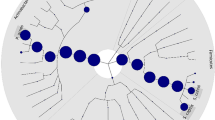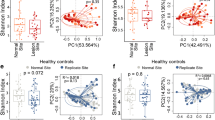Abstract
Tinea capitis is a dermatophyte infection of the scalp that is most often seen in prepubescent children. In this investigation, we examined the prevalence of tinea capitis and symptom-free colonization of the scalp with dermatophytes in 786 pre- and postmenopausal women aged 12–84 years. Scalp samples were collected from all participants by cytobrush or hairbrush, and cultures were then grown from these samples on Sabouraud glucose agar. No participant was diagnosed with tinea capitis; however, one 43-year-old patient (0.1%) was positive for a “scalp carriage” related to anthropophilic Trichophyton rubrum, as detected using a hairbrush. The internal transcribed spacer (ITS) regions of the isolate were sequenced, and the assembled DNA sequences were examined using the basic BLAST (nucleotide–nucleotide) software of the National Center for Biotechnology Information Web database. This patient was followed up without any antimycotic treatment, and after 4 weeks, mycological clearance was documented. In addition, the contacts and environment at home were screened, where all fungal cultures were sterile. To the best of our knowledge, this study is the first report of a “scalp carriage” related to a cosmopolitan fungus, T. rubrum.

Similar content being viewed by others
References
Gupta AK, Summerbell RC. Tinea capitis. Med Mycol. 2000;38:255–87.
Buckley DA, Fuller LC, Higgins EM, du Vivier AWP. Tinea capitis in adults. BMJ. 2000;320:1389–90.
Cremer G, Bournerias I, Vandemeleubroucke E, Houin R, Revuz J. Tinea capitis in adults: misdiagnosis or reappearance? Dermatology. 1997;194:8–11.
Romano C. Tinea capitis in Siena, Italy: an 18-year survey. Mycoses. 1999;42:559–62.
Babel DE, Baughman SA. Evaluation of the adult carrier state in juvenile tinea capitis caused by Trichophyton tonsurans. J Am Acad Dermatol. 1989;21:1209–12.
Vargo K, Cohen BA. Prevalence of undetected tinea capitis in household members of children with disease. Pediatrics. 1993;92:155–7.
Pomeranz AJ, Sabnis SS, Mc Grath JJ, Esterly NB. Asymptomatic dermatophyte carriers in the households of children with tinea capitis. Arch Pediatr Adolesc Med. 1999;153:483–6.
White JM, Higgins EM, Fuller LC, et al. Screening for asymptomatic carriage of Trichophyton tonsurans in household contacts of patients with tinea capitis: results of 209 patients from South London. J Eur Acad Dermatol Venereol. 2007;21:1061–4.
Akbaba M, Ilkit M, Sutoluk Z, Ates A, Zorba H. Comparison of hairbrush, toothbrush, and cotton swab methods for diagnosing asymptomatic dermatophyte scalp carriage. J Eur Acad Dermatol Venereol. 2008;22:356–62.
Gianni C, Betti R, Perotta E, Crosti C. Tinea capitis in adults. Mycoses. 1995;38:329–31.
Barlow D, Saxe N. Tinea capitis in adults. Int J Dermatol. 1988;27:388–90.
Fuller LC. Changing face of tinea capitis in Europe. Curr Opin Infect Dis. 2009;22:115–8.
Devliotou-Panagliotidou D, Koussidou-Eremondi T, Chaidemenos GC, Theodoridou M, Minas A. Tinea capitis in adults during 1981–95 in Northern Greece. Mycoses. 2001;44:398–400.
Kurdak H, Sezer T, Ilkit M, Ates A, Bozdemir N. Survey of scalp dermatophyte carriage in a day care center in Turkey. Mycopathologia. 2009;167:139–44.
Ilkit M, Saraclı MA, Kurdak H, et al. Clonal outbreak of Trichophyton tonsurans tinea capitis gladiatorum among wrestlers in Adana, Turkey. Med Mycol. 2010;48:480–5.
Ilkit M, Demirhindi H, Yetgin M, et al. Asymptomatic scalp dermatophyte carriage in school children in Adana, Turkey. Mycoses. 2007;50:130–4.
Bonifaz A, Isa-Isa R, Araiza J, et al. Cytobrush culture method to diagnose tinea capitis. Mycopathologia. 2007;169:309–13.
Ilkit M, Demirhindi H. Asymptomatic dermatophyte scalp carriage: laboratory diagnosis, epidemiology, and management. Mycopathologia. 2008;165:61–71.
Turin L, Riva F, Galbiati G, Cainelli T. Fast, simple and highly sensitive double-rounded polymerase chain reaction assay to detect medically relevant fungi in dermatological specimens. Eur J Clin Invest. 2000;30:511–8.
Hall TA. BioEdit: a user-friendly biological sequence alignment editor and analysis program for windows 95/98 NT. Nucl Acids Symp Ser. 1999;41:95–8.
Pipkin JL. Tinea capitis in the adult and adolescent. AMA Arch Derm Syphilol. 1952;66:9–40.
Bergson CL, Fernandes NC. Tinea capitis: study of asymptomatic carriers and sick adolescents, adults and elderly who live with children with the disease. Rev Inst Med Trop Sao Paulo. 2001;43:87–91.
Honig PJ. Tinea capitis: recommendations for school attendance. Pediatr Infect Dis J. 1999;18:211–4.
Sehgal VN, Saxena KN, Kumari S. Tinea capitis: a clinicoetiologic correlation. Int J Dermatol. 1985;24:116–9.
Schwinn A, Ebert J, Brocker EB. Frequency of Trichophyton rubrum in tinea capitis. Mycoses. 1995;38:1–7.
Anstey A, Lucke TW, Philpot C. Tinea capitis caused by Trichophyton rubrum. Br J Dermatol. 1996;135:113–5.
Khosravi AR, Aghamirian MR, Mahmoudi M. Dermatophytes in Iran. Mycoses. 1994;37:43–8.
Kanwar AJ, Belhaj MS. Tinea capitis in Benghazi, Libya. Int J Dermatol. 1987;26:371–3.
Price VH, Rosenthal SA, Villafane J. Black dot tinea capitis caused by Trichophyton rubrum. Arch Dermatol. 1963;87:487–8.
Ziemer A, Kohl K, Schröder G. Trichophyton rubrum-induced inflammatory tinea capitis in a 63-year-old man. Mycoses. 2005;48:76–9.
Zhu M, Li L, Wang J, et al. Tinea capitis in southeastern China: a 16-year survey. Mycopathologia. 2010;169:235–9.
Chang SE, Kang SK, Choi JH, et al. Tinea capitis due to Trichophyton rubrum in a neonate. Pediatr Dermatol. 2002;19:356–8.
Bargman H. Trichophyton rubrum tinea capitis in a 85-year-old woman. J Cutan Med Surg. 2000;4:153–4.
Ungar L, Laude TA. Tinea capitis in a newborn caused by two organisms. Pediatr Dermatol. 1997;14:229–30.
Acknowledgments
This study was supported by the Research Fund of Cukurova University (Project No: TF2010BAP14). We gratefully acknowledge Prof Dr G. Sybren de Hoog’s (Centraalbureau voor Schimmelcultures, Utrecht, The Netherlands) kind cooperation and confirmation of the isolate examined in this study.
Author information
Authors and Affiliations
Corresponding author
Rights and permissions
About this article
Cite this article
Toksöz, L., Güzel, A.B., Ilkit, M. et al. Scalp Dermatophyte Carriage in Pregnant, Pre-, and Postmenopausal Women: A Comparative Study Using the Hairbrush and Cytobrush Methods of Sample Collection. Mycopathologia 171, 339–344 (2011). https://doi.org/10.1007/s11046-010-9377-3
Received:
Accepted:
Published:
Issue Date:
DOI: https://doi.org/10.1007/s11046-010-9377-3




